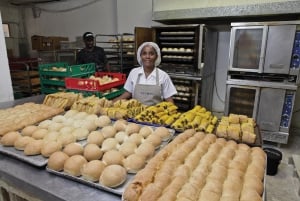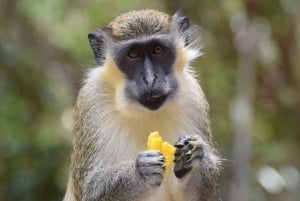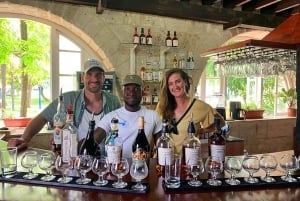Culinary Heritage
Book Top Experiences and Tours in Barbados:
If youʻre booking your trip to Barbados last minute, we have you covered. Below are some of the top tours and experiences!- Bridgetown: Carlisle Bay Turtle and Shipwreck Boat Cruise
- Barbados: 4 Hour Private Customized Island Tour
- Barbados: Catamaran Tour with Snorkeling and Lunch
- Barbados: Carlisle Bay Beach Day and Turtle Swim Experience
- Barbados: Tour of Harrison's Cave & Hunte's Gardens
ball and then dented in the middle to hold the gravy with fresh herbs, spices and rolled flying fish.
The cornerstone of Bajan cooking is the widespread use of herbs and spices. They grow year round, often in people’s backyards, and are always available fresh. One of the most convenient ways of adding these wonderful herbs to a dish is what is referred to as ‘seasoning’- a mixture of finely chopped thyme, marjoram, parsley, celery, basil, bay leaf, spring onions, onions, garlic, and scotch bonnet pepper with spices such as clove, cumin, black pepper, paprika and salt. It is available readymade but the homemade version is often better. When stored in the fridge, it lasts for months and is a wonderful time saver for the busy cook. Meat, chicken and fish are marinated in a liberal amount of Bajan seasoning before being cooked.
Say beef to a Bajan and they’ll say stew. Tasty stews are also made with black belly lamb and pork. Pork is traditionally roasted with the skin scored and baked into crispy crackling. Chicken, baked whole, is a traditional dish in most Bajan households. Bajans eat a vast amount of chicken per capita and, like pork, it is all produced here in Barbados. It is stewed, barbequed, fried, cooked up with rice, and curried.
Our curry culture can be said to have come from Guyana and Trinidad in the southern Caribbean with their large East Indian populations. A roti, pronounced ‘Row T’, is a curry wrapped in a roti skin and it has become one of Barbados’ most popular fast foods. Following on the heals of the roti are ‘doubles’, two fried bara, filled with curried chick peas (channa) and dressed with kuchela, shadon beni pepper sauce, pickled cucumber and tamarind sauce. They are sold by ‘doubles’ vendors at strategic roadside locations.
Interestingly, Barbados and Japan have the highest percentage of centenarians in the world. On numerous occasions throughout the year, the Governor General has the pleasure of visiting a centenarian to deliver a card from Her Majesty Queen Elizabeth II to toast their milestone. These occasions are duly covered in the press with an interview on how they account for their longevity. A frequent reason given is the fact that they eat plenty of ground provisions. Sweet potato, yam, eddo and cassava are four root crops that represent our Amerindian heritage. Although long disappeared from the island when the English arrived in 1627, Amerindians were brought from other islands to advise the new settlers in agriculture and these root crops were central to the Amerinidan diet. Handled much as you would potato, they are also made into all kinds of delicious dishes such as yam pie, candied sweet potato and “big” soups.
Breadfruit is another starch served with meals. This large green football sized fruit, which grows on a tree, was brought here by Captain Bligh on his second attempt after the famous mutiny on the Bounty. It is similar to potato with a slightly more creamy texture and subtle difference in taste that makes it an appealing alternative. It is served lathered in a tomato and onion butter sauce or pickled in a fresh cucumber and lime souse. It can be mashed into a cou cou or fried into crisp, wafer thin chips. Green (unripe) bananas, which are extremely high in iron, are boiled and mashed into a cou cou, curried, soused or added to stews and soups in dumpling sized pieces. Rice and Peas is made using pigeon peas, black eye peas or split peas. Having spoken about all these healthy starches, strangely enough, the most popular is actually an American importation, macaroni and cheese, referred to simply as ‘pie’. With that special Bajan touch of just enough pepper, along with tons of butter and cheese, it is probably served more in Barbados than any other single dish.
Ackee, mamee apple, hog plum, soursop, fat pork, sea grape, guava, tamarind, sugar apple and golden apple are some of the more unusual fruit grown here and sold by vendors along the highway or in Bridgetown. The more familiar tropical fruits like mango, paw paw, pineapple, melon and citrus are usually found in markets and supermarkets. There is a new trend of producing local juices using fruit such as golden apple, mango, and tamarind–look out for them in supermarkets.
Of course the drink that tickles everyone’s fancy in Barbados is rum punch. Many people have their own concoction but basically it is made with 1 measure of fresh lime juice, 2 measures of local sugar syrup, 3 measures of dark rum, 4 measures of water, liberally sprinkled with grated nutmeg and finished off with a few dashes of Angostura bitters. To make local sugar syrup just boil up sugar with a little water until the sugar is dissolved. You can make the rum punch slightly more interesting by steeping a few spices in the hot syrup such as cloves, black peppercorns and cinnamon.
A far healthier drink that Bajans consume in large quantities is coconut water, sold along the roadsides straight from the green coconuts, in 1 litre bottles for BB$12 each. It is also nice mixed with rum, whiskey or gin. The vendors will also cut the coconuts in half so that you may eat the ‘jelly’ out of the not yet matured coconut shell.
Bajans have quite a sweet tooth. Stodgy banana bread or spicy coconut bread go well with a hot cup of afternoon tea. The traditional Bajan desserts that appear on buffet tables are tangy lemon meringue pie, stewed guava with icecream, chocolate icebox pudding, pineapple upside down cake, bread and butter pudding and Bajan baked custard. The traditional local candies, guava cheese, tamarind balls, peanut brittle and chocolate fudge, are all available in supermarkets and make great gifts.



















